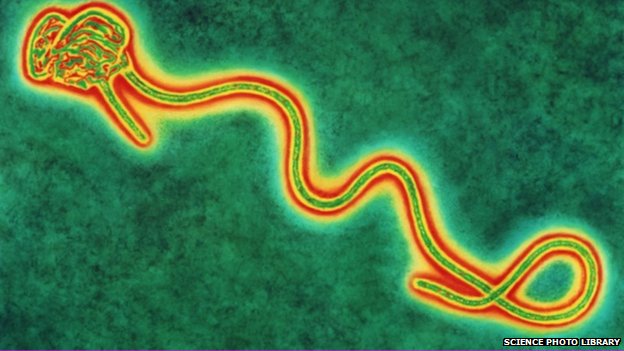The news about Ebola Virus Disease (EVD) is spreading in Nigeria, some people being indifferent while some exercising fear that it may catch up with us. Another group is also concern about getting simple information about the virus to ensure better preparedness and prevention. Already WHO has confirmed an outbreak in West Africa in Sierra Leone, Liberia, and Guinea. Between 18th – 20th July 2014, 45 new cases and 28 deaths were reported from Guinea, Liberia, and Sierra Leone. These include suspect, probable, and laboratory-confirmed cases. Some newspaper have reported that the 1st case of Ebola is confirmed in Lagos, Nigeria. This development amplify apprehension which necessitated providing simple information about Ebola.
Ebola virus disease (formerly known as Ebola haemorrhagic fever) is a severe, often fatal illness, with a case fatality rate of up to 90%. It is one of the world’s most virulent diseases. The infection is transmitted by direct contact with the blood, body fluids and tissues of infected animals or people. Severely ill patients require intensive supportive care. During an outbreak, those at higher risk of infection are health workers, family members and others in close contact with sick people and deceased patients.
Ebola virus disease outbreaks can devastate families and communities, but the infection can be controlled through the use of recommended protective measures in clinics and hospitals, at community gatherings, or at home. The illness affects humans and nonhuman primates (monkeys, gorillas, and chimpanzees). Ebola first appeared in 1976 in two simultaneous outbreaks, one in a village near the Ebola River in the Democratic Republic of Congo, and the other in a remote area of Sudan.
How do people become infected with the virus?
Ebola is introduced into the human population through close contact with the blood, secretions, organs or other bodily fluids of infected animals. In Africa, infection has occurred through the handling of infected chimpanzees, gorillas, fruit bats, monkeys, forest antelope and porcupines found ill or dead or in the rainforest. It is important to reduce contact with high-risk animals (i.e. fruit bats, monkeys or apes) including not picking up dead animals found lying in the forest or handling their raw meat.
Once a person comes into contact with an animal that has Ebola, it can spread within the community from human to human. Infection occurs from direct contact (through broken skin or mucous membranes) with the blood, or other bodily fluids or secretions (stool, urine, saliva, semen) of infected people. Infection can also occur if broken skin or mucous membranes of a healthy person come into contact with environments that have become contaminated with an Ebola patient’s infectious fluids such as soiled clothing, bed linen, or used needles.
Burial ceremonies in which mourners have direct contact with the body of the deceased person can also play a role in the transmission of Ebola. Persons who have died of Ebola must be handled using strong protective clothing and gloves, and be buried immediately. People are infectious as long as their blood and secretions contain the virus. For this reason, infected patients receive close monitoring from medical professionals and receive laboratory tests to ensure the virus is no longer circulating in their systems before they return home. When the medical professionals determine it is okay for the patient to return home, they are no longer infectious and cannot infect anyone else in their communities. Men who have recovered from the illness can still spread the virus to their partner through their semen for up to 7 weeks after recovery. For this reason, it is important for men to avoid sexual intercourse for at least 7 weeks after recovery or to wear condoms if having sexual intercourse during 7 weeks after recovery.
Who is most at risk?
- During an outbreak, those at higher risk of infection are:
- Health workers;
- Family members or others in close contact with infected people;
- Mourners who have direct contact with the bodies of the deceased as part of burial ceremonies; and
- Hunters in the rain forest who come into contact with dead animals found lying in the forest.
What are typical signs and symptoms of infection?
Sudden onset of fever, intense weakness, muscle pain, headache and sore throat are typical signs and symptoms. This is followed by vomiting, diarrhoea, rash, impaired kidney and liver function, and in some cases, both internal and external bleeding. The incubation period, or the time interval from infection to onset of symptoms, is from 2 to 21 days. The patient becomes contagious once they begin to show symptoms. They are not contagious during the incubation period. Ebola virus disease infections can only be confirmed through laboratory testing.
When should someone seek medical care?
If a person has been in an area known to have Ebola virus disease or in contact with a person known or suspected to have Ebola and they begin to have symptoms, they should seek medical care immediately. Prompt medical care is essential to improving the rate of survival from the disease. It is also important to control spread of the disease and infection control procedures need to be started immediately. Severely ill patients require intensive supportive care. They are frequently dehydrated and need intravenous fluids or oral rehydration with solutions that contain electrolytes. There is currently no specific treatment to cure the disease. To help control further spread of the virus, people that are suspected or confirmed to have the disease should be isolated from other patients and treated by health workers using strict infection control precautions.
This article was 1st published in Daily Trust Newspaper of Tuesday 29th July 2014 by Dr Aminu Magashi




